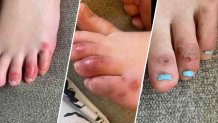As the COVID pandemic enters its third winter, many now know that not everyone experiences the same symptoms. But for some, the symptoms might seem particularly strange.
While many may experience fevers, coughs, congestion and more, there are some unexpected symptoms that could sprout.
Things like hair loss, rashes, COVID toes and more have led many to question -- is it COVID?
Whether it's a breakthrough infection, a first time infection or something else, Chicago Department of Public Health Commissioner Dr. Allison Arwady said Tuesday that experts aren't seeing much change in symptoms for November 2022.
Feeling out of the loop? We'll catch you up on the Chicago news you need to know. Sign up for the weekly Chicago Catch-Up newsletter here.
But that doesn't mean that some people won't experience the stranger side of COVID.
Here's a look at some of the more unusual COVID symptoms and what you should watch for:
COVID Hair Loss
Local
According to the American Academy of Dermatology Association, "many people find that their hair is falling out in large clumps" months after they've recovered from COVID.
A study published in January 2021 looked at nearly 1,700 people discharged from the hospital after having COVID and found that 22% reported hair loss as a symptom within six months following their recovery.
A similar study in May of this year aimed at determining the prevalence of the condition found that out of 198 patients admitted for COVID-19, 48 showed hair loss.
The AAD, however, says that such a response may not be unexpected.
"Fever is a common symptom of COVID-19. A few months after having a high fever or recovering from an illness, many people see noticeable hair loss," the association reported. "While many people think of this as hair loss, it’s actually hair shedding."
The medical term for "hair shedding" is known as "telogen effluvium," which the National Library of Medicine says is "characterized by an abrupt onset of diffuse hair loss usually seen two-three months after a triggering event."
On a healthy scalp, roughly 85% of hairs are said to be known as "anagen" or "actively growing." Another 15% are typically "telogen," which means they are resting. A few hairs may also be catagen, which is essentially in between the two.
"A hair follicle usually grows anagen hair for almost four years, then rests for about four months," the National Library of Medicine states. "A new anagen hair begins to grow under the resting telogen hair and pushes it out. If there is some kind of stress to the body it can cause 70% of anagen hair to precipitate into the telogen phase thus causing hair loss."
The hair loss can last for up to six months, according to the NLM, but chronic telogen effluvium can extend beyond that timeframe.
"Handfuls of hair can come out when you shower or brush your hair," AAD reports. "This hair shedding can last for six to nine months before it stops. Most people then see their hair start to look normal again and stop shedding."
Even those who don't experience a fever can still have the symptom, some experts say.
That's because stress can also trigger the condition, according to both researchers and medical experts.
A report from the University of Utah noted a similar claim as a COVID infection can be a major stressor for many people.
Dr. Powell Perng, a dermatologist at University of Utah Health, said most patients with chronic telogen effluvium will not lose all of their hair.
University of Utah health officials said most cases of telogen effluvium cases are over in about three to six months, and in COVID patients it could be even sooner - about three months.
COVID Rash
Rashes have been an unusual symptoms in both children and adults since the start of the pandemic.
The Mayo Clinic reported last fall that "most children with COVID-19 infection have mild symptoms, and a rash may be the only sign of infection."
Meanwhile, a number of rashes, including chickenpox-like rashes, can develop across age groups, according to Dr. Dawn Davis, chair of the Division of Clinical Dermatology at Mayo Clinic.
"Another common rash form we are seeing with COVID-19 infection is a varicelliform rash or chickenpoxlike rash," Davis said. "The rash will be small round ovals on the skin with a center that shows a bit of fluid, like a bubble or small blister. It's similar to what we call a 'dewdrop on a rose petal' seen in chickenpox. If you develop a rash you think looks like chickenpox, and you don't believe you could have chickenpox or shingles, consider contacting your provider to have this investigated."
Arwady previously noted that while rashes can be related to COVID symptoms, they are not among the more common symptoms.
COVID Toes
COVID toe is a painful skin condition that stems from the body's immune response to COVID-19.
Cases of the mysterious skin condition that causes purple, blue or red discoloration in toes and occasionally fingers began popping up around the country early on during the pandemic, according to Northwestern doctors, leading some dermatologists to wonder if it may be connected to coronavirus.
The bizarre symptom, which in some cases can last for months, has been reported throughout the pandemic, though COVID toes are not as prevalent as other common symptoms associated with the virus.
Doctors said the condition appears similar to one known as pernio, which happens in response to cold, but "COVID toes" varies from bright red to purple and affects broader areas of the toes and sometimes even the bottoms of feet and fingers. Feet can occasionally become itchy, painful or may show no other symptoms besides discoloration.

"We think something like this may be happening in response to the inflammation, perhaps caused as part of the response to the COVID-19 virus," Dr. Amy Paller, a dermatologist for Northwestern Medicine said.
According to the American Academy of Dermatology Association, many people "only realize that they have COVID toes when they see the discoloration and swelling on their feet (or hands)."
"Along with the swelling and discoloration, COVID toes can also cause blisters, itch, or pain," the group's website reads. "Some people develop painful raised bumps or areas of rough skin. Others may see a small amount of pus under their skin. Sometimes, people who have COVID toes have other symptoms of COVID-19."
Most Common Symptoms
Some of COVID's most common symptoms, particularly in 2022 so far, overlap with several conditions, including cold, RSV and flu.
While upper respiratory symptoms are currently the most tell-tale sign of the virus, some changes in symptoms have been observed as the virus has evolved.
"We see a lot of things happening with the virus changing, you know," said Dr. Isaac Ghinai earlier this month, a medical director for the Chicago Department of Public Health who oversees COVID-19 testing and laboratory surveillance. "Omicron and its sub-lineages are an example of the virus changing a bit, and there are indications that different lineages of the virus can cause slightly different symptoms."
Ghinai said that differences in symptoms may also be impacted by the introduction of vaccines and their subsequent widespread utilization nearly one year into the pandemic.
"There are some indications for example, with omicron that the loss of taste and smell is less common than it was with some of the earlier lineages. All of this is also impacted probably by the fact that many more people are vaccinated than they were before," Ghinai said.
According to Johns Hopkins Medicine, early symptoms of COVID typically include fatigue, headache, sore throat or a fever.
A study by researchers at the University of Southern California found fever may be first, as well as a cough and muscle pain. Then, those infected will likely experience nausea, vomiting or diarrhea. Unlike other respiratory illnesses such as MERS and SARS, COVID patients will likely develop nausea and vomiting before diarrhea, the researchers found.
Digestive symptoms, in some instances, may be the first sign someone has contracted COVID. They have been known to develop at the beginning of an infection, with respiratory symptoms possibly following a day later, according to an article from Emerson Health.
Still, some symptoms, such as shortness of breath, have become less prevalent as the virus continues to mutate. Dr. Sharon Welbel, the director of Hosptial Epidemiology and Infection Control for Cook County Health said earlier this month that fevers and coughs have become more common symptoms in recent months.
"In terms of symptoms and what people have it's been so incredibly heterogeneous," Welbel said. "I find with omicron we do know that still the most common is fever, cough - not so much shortness of breath anymore."
As for the symptoms that often stick around the longest? A cough.
"That's the thing that's going to last the longest, almost always," Chicago's top doctor Allison Arwady said at a press conference earlier this month. "A cough tends to be the most lingering effect. That's true whenever you have any viral infection. You can be feeling totally better, and you're still going to have some irritation."
Most common symptoms of the virus include:
-Fever or chills
-Cough
-Shortness of breath
-Fatigue
-Muscle or body aches
-Headache
-New loss of taste or smell
-Sore throat
-Congestion or runny nose
-Nausea or vomiting
-Diarrhea
Patients are urged to seek emergency medical attention if they experience:
-Trouble breathing
-Persistent chest pain or pressure
-New confusion
-Inability to wake or stay awake
-Pale, gray, or blue-colored skin, lips, or nail beds



